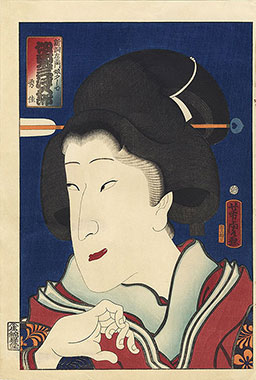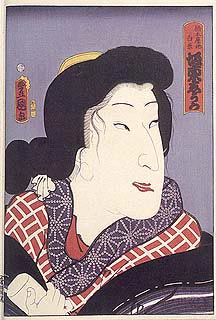

Utagawa Yoshitora (歌川芳虎)
The set was originally scheduled to include 150 works by the leading designer of actor prints, Utagawa Kunisada; unfortunately, it was never completed. Only 72 published designs are known, with 12 by Yoshitora, plus two proof prints and two preparatory drawings, for a total of 76 known compositions. Yoshitora joined the project in 1862 for unconfirmed reasons (possibly to assist an overworked or ailing Kunisada). The series was intended to be the crowning achievement in Kunisada's career, with no effort or expense spared in its size or production.
See the figure on the left, where Kunisada depicted the same actor as in Yoshitora's design (in this case, however, the inscription on the print indicates his lifetime stage name, Bandô Shuka), who plays the role of Hashimotoya in the play Kasane tsuna uru sayogime at the Ichimura Theater, 3/1852. It is signed Toyokuni ga (the artist's most familiar signature from 1844 until his death in January 1865) and has the mark of the same block cutter employed on Yoshitora's design. The print bears a date seal for 6/1860, consistent with many examples in the series portraying actors from performances given years before the publication of the set. In terms of their quality (beautifully executed block cutting, exceptional colors, embossing, and burnishing), the prints from this series are reminiscent of the deluxe limited editions produced in the smaller chûban format in Osaka during the mid-nineteenth century (most familiar among them are the prints of Hirosada). © 1999-2020 by John Fiorillo BIBLIOGRAPHY
|
Viewing Japanese Prints |
 The figure at the top right is an ôban-size print by Utagawa Yoshitora (
The figure at the top right is an ôban-size print by Utagawa Yoshitora ( Kunisada set the tone for the series by producing an exceptionally fine group of actor portraits. He also provided models for the depiction of
Kunisada set the tone for the series by producing an exceptionally fine group of actor portraits. He also provided models for the depiction of